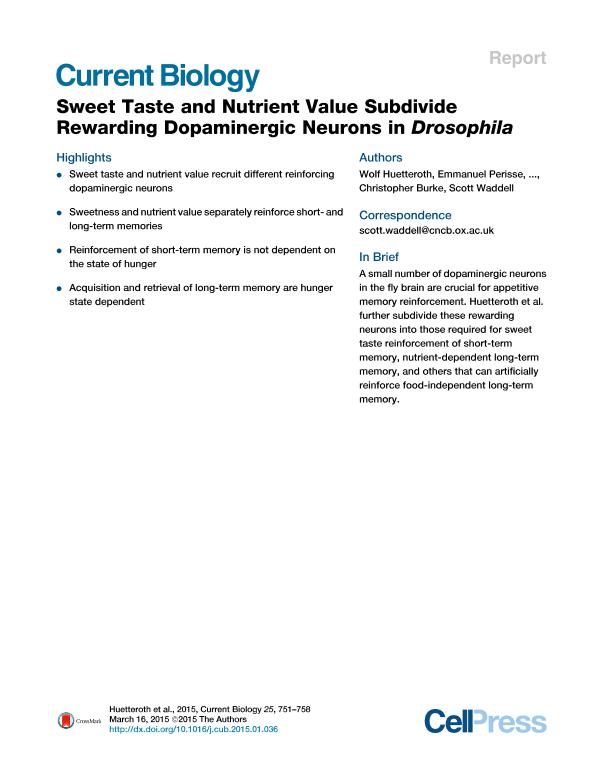Artículo
Sweet taste and nutrient value subdivide rewarding dopaminergic neurons in drosophila
Huetteroth, Wolf; Perisse, Emmanuel; Lin, Suewei; Klappenbach, Martín ; Burke, Christopher; Waddell, Scott
; Burke, Christopher; Waddell, Scott
 ; Burke, Christopher; Waddell, Scott
; Burke, Christopher; Waddell, Scott
Fecha de publicación:
03/2015
Editorial:
Cell Press
Revista:
Current Biology
ISSN:
0960-9822
Idioma:
Inglés
Tipo de recurso:
Artículo publicado
Clasificación temática:
Resumen
Dopaminergic neurons provide reward learning signals in mammals and insects [1-4]. Recent work in Drosophila has demonstrated that water-reinforcing dopaminergic neurons are different to those for nutritious sugars [5]. Here, we tested whether the sweet taste and nutrient properties of sugar reinforcement further subdivide the fly reward system. We found that dopaminergic neurons expressing the OAMB octopamine receptor [6] specifically convey the short-term reinforcing effects of sweet taste [4]. These dopaminergic neurons project to the β′2 and γ4 regions of the mushroom body lobes. In contrast, nutrient-dependent long-term memory requires different dopaminergic neurons that project to the γ5b regions, and it can be artificially reinforced by those projecting to the β lobe and adjacent α1 region. Surprisingly, whereas artificial implantation and expression of short-term memory occur in satiated flies, formation and expression of artificial long-term memory require flies to be hungry. These studies suggest that short-term and long-term sugar memories have different physiological constraints. They also demonstrate further functional heterogeneity within the rewarding dopaminergic neuron population.
Palabras clave:
Dopamine
,
Reward
,
Drosophila
Archivos asociados
Licencia
Identificadores
Colecciones
Articulos(IFIBYNE)
Articulos de INST.DE FISIOL., BIOL.MOLECULAR Y NEUROCIENCIAS
Articulos de INST.DE FISIOL., BIOL.MOLECULAR Y NEUROCIENCIAS
Citación
Huetteroth, Wolf; Perisse, Emmanuel; Lin, Suewei; Klappenbach, Martín; Burke, Christopher; et al.; Sweet taste and nutrient value subdivide rewarding dopaminergic neurons in drosophila; Cell Press; Current Biology; 25; 6; 3-2015; 751-758
Compartir
Altmétricas



